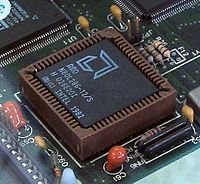Intel 80286
 An Intel 80286 Microprocessor | |
| General information | |
|---|---|
| Launched | 1982 |
| Discontinued | 1986 |
| Common manufacturers |
|
| Performance | |
| Max. CPU clock rate | 6 MHz to 25 MHz |
| Architecture and classification | |
| Technology node | 1.5 |
| Instruction set | x86 |
| Physical specifications | |
| Cores |
|
| Socket |
|

The Intel's 286[1], introduced on February 1, 1982, (originally named 80286, and also called iAPX 286 in the programmer's manual) was an x86 16-bit microprocessor with 134,000 transistors. After the 6 and 8 MHz initial releases, it was subsequently scaled up to 12.5 MHz. (AMD and Harris later pushed the architecture to speeds as high as 20 MHz and 25 MHz, respectively.) It was widely used in IBM PC compatible computers during the mid 1980s to early 1990s. On average, the 80286 had a speed of about 0.21 million instructions per second (MIPS) per MHz; [1] the 6 MHz model operated at 0.9 MIPS, the 10 MHz model at 1.5 MIPS, and the 12 MHZ model at 2.66 MIPs.[2]
The 80286's performance was more than twice that of its predecessors (the Intel 8086 and Intel 8088) per clock cycle. In fact, the performance increase per clock cycle may be the largest among the generations of x86 processors. Calculation of the more complex addressing modes (such as base+index) had less clock penalty because it was performed by a special circuit in the 286; the 8086, its predecessor, had to perform effective address calculation in the general ALU, taking many cycles. Also, complex mathematical operations (such as MUL/DIV) took fewer clock cycles compared to the 8086. The 286 was able to address up to 16 MB of RAM, in contrast to 1 MB the 8086 could work with. While DOS could utilize this additional RAM via extended memory emulation, cost and initial rarity of software utilizing extended memory meant that many 286 computers were never equipped with more than a megabyte of ram.
The 286 was designed to run multitasking applications, including communications (such as automated PBXs), real-time process control, and multi-user systems.
The later E-stepping level of the 80286 was a very clean CPU - free of the several significant errata that caused problems for programmers and operating system writers in the earlier B-step and C-step CPU's (common in the AT and AT clones).
An interesting feature of this processor is that it was the first x86 processor with protected mode. Protected mode enabled up to 16 MiB of memory to be addressed by the on-chip linear memory management unit (MMU) with 1 GiB logical address space. The MMU also provided some degree of prevention from (crashed or ill-behaved) applications writing outside their allocated memory zones. However, the 286 could not revert to the basic 8086-compatible "real mode" without resetting the processor (though some very clever programmers did figure out a way to re-enter real mode via a series of software instructions which would execute the reset while retaining active memory and control).
In theory, real mode applications could be directly executed in 16-bit protected mode if certain rules were followed; however, as many DOS programs broke those rules protected mode was not widely used until the appearance of its successor, the 32-bit Intel 80386, which was designed to go back and forth between modes easily. See Protected mode#Real mode application compatibility for more info.
The 80286 provided the first glimpse into the world of the protection mechanisms then exclusive to the world of mainframes and minicomputers which would pave the way for the x86 and the IBM PC architecture to extend from the personal computer all the way to high-end servers, drive the market for other architectures all the way down to only the highest-end servers and mainframes, and blur the differences between microcomputers and mainframes, a fact which presumably gave the IBM PC/AT its name.
Notes and references
- ^ "Microprocessor Hall of Fame". Intel. Retrieved 2007-08-11.
